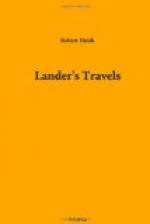[Footnote: One of the numerous discordances between the different translations of Leo, occurs in the passage here alluded to. The meaning of the Italian version is simply this, that “the dwellings of the people of Timbuctoo are cabins or huts, constructed with stakes, covered with chalk or clay, and thatched with straw, ’le cui case sono capanne fatte di pali coperte di creta co i cortivi di paglia.’ But the expression in the Latin translation, which is closely followed by the old English translator, Pery, implies a state of previous splendour and decay, ’cojus domus omnes in tuguriola, stramineis tectis, sunt mutatae.’”]
But whatever may be the degree of Adams’ coincidence with other authorities, in his descriptions of the population and local circumstances of Timbuctoo, there is at least one asserted fact in this part of his narrative, which appears to be exclusively his own; the existence, we mean, of a considerable navigable river close to the city. To the truth of which, the credit of Adams is completely pledged. On many other subjects it is possible that his narrative might be considerably at variance with the truth, by a mere defect of memory or observation, and without justifying any imputation on his veracity, but it is evident that no such latitude can be allowed him in respect to the La Mar Zarah, which, if not in substance true, must be knowingly and wilfully false.
We shall conclude our remarks on Adams’ narrative, by noticing only two important circumstances, respectively propitious and adverse to the progress of discovery and civilization, which is decidedly confirmed by the account of Adams, viz. the mild and tractable natures of the pagan negroes of Soudan, and their friendly deportment towards strangers, on the one hand; and, on the other, the extended and baneful range of that original feature of African society —slavery.
CHAPTER XIV.
Previously to entering into any further detail of the different expeditions for exploring the interior of Africa, it may be greatly conducive to the better understanding of the subsequent narratives, when treating of the distinct races of people by which the countries are inhabited, to give a concise statement of the population of that part of Africa, which is known by the appellation of West Barbary, and which may be said to be divided into three great classes, exclusive of the Jews, viz. Berrebbers, Arabs, and Moors. The two former of these are, in every respect, distinct races of people, and are each again subdivided into various tribes or communities; the third are chiefly composed of the other two classes, or of their descendants, occasionally mixed with the European or negro races. The indiscriminate use of the names Arab and Moor, in speaking apparently of the same people, frequently leads the reader into an error as to the real class to which the individual belongs, and thus the national character of the two classes becomes unjustly confounded, whilst at the same time an erroneous opinion is formed of the relative virtues and vices of the different people, with whom the traveller is brought into collision.




